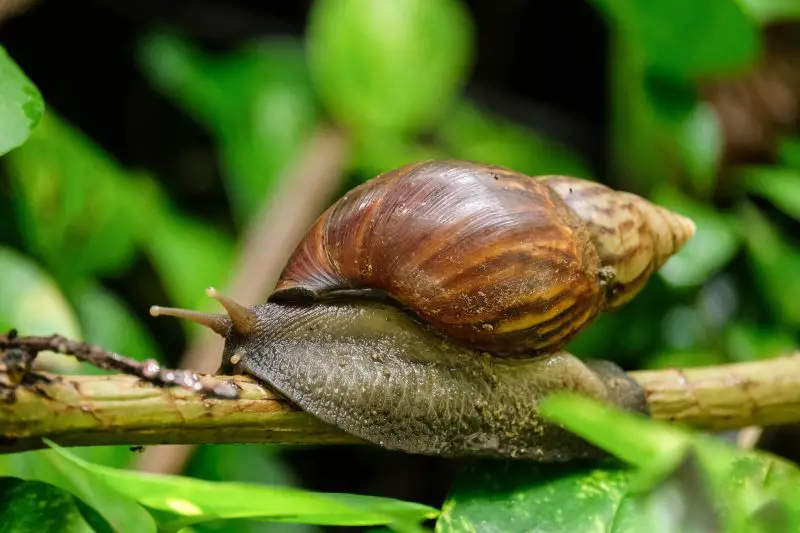When you picture Hawaii, you probably imagine lush rainforests, colorful birds, and turquoise waves washing over volcanic shores. But hidden among the island’s ferns and banana trees lurks a slow-moving invader that’s both fascinating and alarming—the giant African land snail (Lissachatina fulica). With shells as big as a human fist and appetites capable of destroying entire gardens overnight, these snails have earned a notorious reputation in the Aloha State.
They’re not native to Hawaii, yet they’ve made themselves at home in its tropical climate, thriving in areas from Hilo to Honolulu. Their arrival, biology, and environmental impact make for a story that’s as bizarre as it is important. Despite their harmless appearance, these snails are at the center of one of Hawaii’s most persistent ecological challenges.
In this detailed guide, we’ll uncover the truth about giant snails in Hawaii you didn’t expect—their origins, habits, risks, and the efforts to control them. You’ll learn how these massive mollusks became both a pest and a symbol of invasive species management across the islands.
What Are Giant African Land Snails?

Physical Description
Giant African land snails are among the largest terrestrial snails in the world. Adults can reach up to 8 inches in length and weigh several ounces. Their shells are brown with cream-colored streaks, forming a spiral pattern that gives them a distinctive, glossy look.
Their size alone is enough to shock anyone who spots one crawling across a sidewalk or hiding under a banana leaf. But their appetite—and what they carry inside—makes them far more dangerous than their appearance suggests.
Lifespan and Reproduction
These snails are hermaphrodites, meaning each individual has both male and female reproductive organs. A single snail can produce hundreds of eggs at a time and lay up to 1,200 eggs per year. This explosive reproduction rate is one reason they spread so quickly once introduced to new environments like Hawaii.
In tropical climates, they can live up to five years, spending their time feeding, breeding, and burrowing into moist soil to avoid heat.
How Did They Get to Hawaii?
The Introduction Story
Giant African land snails were brought to Hawaii in 1936 by a local resident who wanted them as pets and potential food. Within a few years, they escaped into the wild—and the population exploded.
By the 1950s, they had spread across multiple Hawaiian islands, infesting gardens, farms, and forests. Efforts to eradicate them failed repeatedly due to their high fertility and ability to survive droughts by sealing themselves inside their shells for months.
The Failed Biological Control
In the 1950s, Hawaii attempted to control the snail population by introducing another species: the rosy wolf snail (Euglandina rosea), a carnivorous snail that preys on other mollusks. Unfortunately, this move backfired catastrophically.
The rosy wolf snail ignored the invasive African species and instead attacked Hawaii’s native tree snails, many of which were already endangered. Today, several native snail species are extinct as a direct result of this failed control attempt—a tragic lesson in the risks of biological interference.
The Threat They Pose
Environmental Impact
Giant African land snails are voracious eaters. They feed on over 500 plant species, including crops like papaya, banana, lettuce, beans, and even tree bark. Their feeding damages crops, ornamental plants, and natural vegetation, disrupting Hawaii’s delicate ecosystems.
When they consume calcium-rich materials—such as concrete or stucco—they further damage urban environments. Their feeding also strips foliage, exposing soil to erosion, which can impact water quality and agriculture.
Disease Carriers
Perhaps the most alarming truth about these snails is that they can carry the rat lungworm parasite (Angiostrongylus cantonensis). This parasite can infect humans if contaminated snail slime gets on produce or surfaces, potentially causing eosinophilic meningitis, a serious neurological disease.
While infections are rare, several cases have been reported in Hawaii in recent years, raising public health concerns. The Centers for Disease Control and Prevention (CDC) recommends careful washing of all fruits and vegetables in areas where the snails are present.
Agricultural Damage
For Hawaii’s farmers, giant snails are a nightmare. They devastate crops overnight and are resistant to many traditional pest control methods. Their presence in agricultural shipments can also lead to quarantine restrictions, hurting local economies dependent on exports.
Behavior and Adaptation
Feeding Habits
These snails are primarily herbivorous, feeding on plant leaves, fruits, stems, and roots. However, when vegetation is scarce, they’ve been observed eating paper, paint, or even other snails.
They are most active at night or after rain when humidity is high. During dry spells, they retreat underground and secrete a thin layer of mucus to seal themselves inside their shells—a process called aestivation—until moisture returns.
Survival Strategies
What makes them particularly hard to control is their resilience. Giant African land snails can survive in various conditions and can go months without food or water. Their thick shells and burrowing habits protect them from predators and environmental extremes.
Their adaptability allows them to thrive not only in rural areas but also in urban gardens, parks, and residential landscapes, where human activity provides both food and shelter.
Where Are They Found in Hawaii?
Geographic Spread
Giant African land snails are mainly found on the Big Island and Oahu, but reports have surfaced from Maui and Kauai as well. They are most abundant in moist, tropical areas with dense vegetation.
Common hotspots include:
- Hilo and Puna District (Big Island)
- Honolulu and surrounding suburbs (Oahu)
- Lowland forests and gardens on Maui
These areas provide ideal conditions—high humidity, warm temperatures, and abundant plant life.
Urban Encroachment
It’s not unusual for residents in Hilo or Honolulu to find these snails crawling along sidewalks, walls, or inside gardens. In some neighborhoods, after heavy rainfall, hundreds can emerge from hiding simultaneously, creating a slimy spectacle that’s both fascinating and unsettling.
Control and Management
Government Efforts
The Hawaii Department of Agriculture (HDOA) has been fighting to control the spread of giant snails for decades. Efforts include:
- Manual removal campaigns.
- Use of approved molluscicides (chemical snail baits).
- Public awareness programs to identify and report sightings.
Officials urge residents to never release snails into the wild and to destroy eggs and adults responsibly. The HDOA’s inspection programs for nurseries and produce shipments also aim to prevent the snails from spreading to new islands or states.
Community Action
Many control efforts rely on citizen participation. Residents are encouraged to:
- Collect and dispose of snails safely using gloves.
- Destroy eggs found in gardens or compost piles.
- Avoid moving potted plants or soil from infested areas.
- Keep yards dry and remove hiding spots like leaf litter and debris.
Education campaigns emphasize early detection, since catching infestations before they spread is the most effective way to prevent large-scale damage.
Myths and Misunderstandings
Myth 1: They Make Good Pets
False. While giant African land snails are kept as pets in some parts of the world, they are illegal to own in Hawaii and the mainland United States without special permits. Their potential for ecological damage makes them one of the most strictly regulated invasive species.
Myth 2: They’re Harmless
False. Their ability to destroy vegetation, spread parasites, and outcompete native species makes them highly dangerous to Hawaii’s biodiversity.
Myth 3: They Only Live in the Wild
False. Many infestations start near homes and gardens. Their adaptability allows them to thrive in both wild and urban areas.
Myth 4: They’re Easy to Kill
False. Their thick shells and resilience make them difficult to eliminate. Chemical treatments and manual collection must be repeated regularly for effective control.
The Ecological Consequences
Threat to Native Snails
Hawaii was once home to over 750 native snail species, many of which are now extinct or endangered. Invasive snails like the giant African land snail compete with them for food and habitat, accelerating the decline of native mollusks.
Combined with predation from the introduced rosy wolf snail, the result has been catastrophic for Hawaii’s unique snail diversity.
Impact on Forest Health
By overgrazing vegetation, giant snails alter forest composition and regeneration. They target seedlings and young plants, disrupting natural growth cycles and weakening the structure of native ecosystems.
Their role as disease carriers also poses risks to wildlife, as other animals may become infected by contact with contaminated slime.
Interesting Facts About Giant Snails in Hawaii
- They’re among the fastest-reproducing land snails on Earth, capable of laying new egg batches every few weeks.
- Their slime can contain parasites, making it unsafe to handle them bare-handed.
- Each snail can consume up to 10% of its body weight in a single night.
- They are nocturnal—you’re most likely to spot them after rain or in the early morning.
- Their introduction led to one of the most tragic native species extinctions in Hawaii’s history.
- They can climb vertical walls and fences easily using their muscular foot and sticky mucus.
- Some individuals live more than 5 years, making them a long-term threat once established.
How to Protect Your Home and Garden
Preventing Infestation
If you live in Hawaii, vigilance is key. You can reduce the risk of infestation by:
- Keeping gardens tidy and removing debris.
- Avoiding overwatering—snails love damp conditions.
- Checking potted plants and soil for eggs before moving them.
- Using copper tape barriers around garden beds.
Safe Removal
If you find a giant snail:
- Wear gloves—never touch it with bare hands.
- Place it in a plastic bag or container.
- Report it to the Hawaii Department of Agriculture hotline.
- Freeze or dispose of it according to official guidance.
Protecting Produce
Wash fruits and vegetables thoroughly before eating or cooking. Pay special attention to leafy greens, which can hide small snails or eggs.
Giant Snails as a Global Problem
Beyond Hawaii
The giant African land snail isn’t just Hawaii’s issue—it’s a global invasive menace. Populations have been reported in Florida, Texas, and parts of Asia and the Caribbean. In each case, eradication has proven extremely difficult.
Lessons from Hawaii
Hawaii’s decades-long battle with giant snails serves as a cautionary tale. Introducing or transporting non-native species can have irreversible ecological consequences. Today, Hawaii’s strict biosecurity laws aim to prevent similar disasters by inspecting imported goods and enforcing quarantine measures.
FAQs About Giant Snails in Hawaii
Are giant snails dangerous to humans?
Yes. They can carry parasites that cause rat lungworm disease if ingested accidentally. Always handle them carefully or avoid touching them altogether.
Can I keep one as a pet?
No. It is illegal in Hawaii and the U.S. mainland due to their invasive nature.
How big can they get?
Up to 8 inches long, with shells large enough to fill an adult’s palm.
Do they have any natural predators?
Few. Some birds and rats may eat them, but they reproduce too quickly for predators to control effectively.
What should I do if I see one?
Report it immediately to the Hawaii Department of Agriculture. Do not release or relocate it.
Can they swim?
No, but they can float short distances, allowing them to spread via flooding or irrigation systems.
Conclusion
The giant African land snail may seem slow and harmless, but the truth about these invaders in Hawaii is far from benign. They’re destructive, resilient, and capable of spreading dangerous parasites, making them one of the state’s most persistent environmental threats.
Yet, their story also highlights an important lesson: the delicate balance of Hawaii’s ecosystems and the consequences of human interference. By learning from past mistakes and taking proactive measures, Hawaii continues to battle these slimy invaders while protecting its incredible biodiversity.
So next time you walk through a Hawaiian garden after a rainfall and see something large and glistening among the leaves, take a closer look—it might just be one of nature’s most unexpected invaders, carrying a lesson as heavy as its shell.






